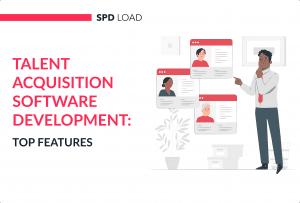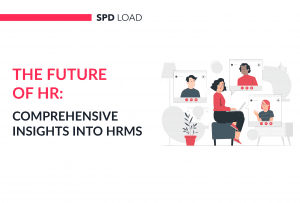Employee Training Software Development: Best Practices and Solutions
- Created: Oct 02, 2024
- 16 min
Lack of professional development is one of the main reasons why employees leave the company.
LinkedIn’s 2023 Workplace Learning Report reveals that 70% of employees are somewhat likely to quit their current workplace and find a place at a company that invests in employee development and learning.
This is eye-opening information for many organizations that are not investing in employee training yet.
With almost 60% of employees claiming they had no training at the workplace and that most of their skills were self-taught, we can see how deep the problem really is.
Employee training is crucial for any organization.
The more qualified your specialists are, the better the outcomes of their work will be.
In the era of digitalization, companies should invest resources into employee training software.
Using this software, your workforce can learn and develop new skills, onboard more effectively, complete compliance training programs faster, and much more.
In this article, we dive deeper into these solutions, explore their types and benefits, and explain how you can develop the best employee training software for your company.
Picking the right development partner is crucial — here’s how to choose an app development company that fits your needs.
Explore our HR development services today!
What is Employee Training Software?
Employee training software is a digital tool designed for employee training and development.
It helps to streamline the learning process and make it more efficient, accessible, and interesting.
With training software, businesses easily deliver, manage, and track training programs.
This is like a one-stop shop for helping employees learn new skills, stay updated on company policies, or even develop into future leaders.
Training courses are a must for most, if not all, organizations out there.
Take Walmart, for example. They used virtual reality training to teach more than 1.2 million employees how to handle different situations.
This online employee training platform is aimed at improving customer service and employee performance at the same time.
And the impact is real.
A survey by LinkedIn showed that 94% of employees would stick with a company longer if it helped them grow through training.
That’s huge!
Plus, companies that invest in employee development see better results.
Now, let’s explore the different types of employee training software.
Types of Employee Training Software
When selecting the best employee training software for your company, it’s important to match the tool to your company’s unique needs.
Let’s break down the most common types of training software, who they’re best suited for, and the must-have features for each:
Learning Management Systems (LMS)
Learning management systems are like digital headquarters for all your company’s training needs.
This centralized platform handles everything from scheduling courses to tracking employee progress.
If your company has many employees or operates in multiple locations, an LMS helps ensure that everyone gets the same training experience, regardless of where they are.
LMS is best suited for big enterprises or companies with structured, standardized training programs.
LMS must-have features:
- Course tracking and reporting for detailed analytics to see who’s completing what training and how they’re performing.
- Certification management. An LMS can automatically track when they need to renew.
- Mobile learning so that employees can train on the go.
Learning Experience Platforms (LXPs)
Learning experience platforms are more flexible and user-friendly than traditional LMS.
LXPs don’t just deliver a training program for the employees. Instead, they create personalized learning paths. These paths are based on the specialist’s needs, career goals, and interests.
This approach works best for companies that want to foster long-term employee growth, as the learning experience feels more engaging and less formal.
Must-have features:
- AI-driven recommendations that suggest relevant courses and content based on the employee’s role, performance, and interests.
- Social learning experience to share content, discuss topics, and learn from one another.
- Gamification elements like quizzes, badges, and leaderboards to help keep employees engaged.
The Difference Between LMS and LXP
LMS and LXP have a lot in common.
They both are methods of distributing training materials to employees.
However, they differ in how that information is controlled.
In the case of LMS, the management fully controls the training content and resources.
Responsible managers set the learning plan and track employee training progress.
With LXP, employees are fully responsible for managing their learning process.
They can control the type and amount of information they want to learn.
Additionally, LXPs are designed with keeping the end user in mind.
This is more than just a content library with analytics and progress-tracking features.
LXP provides an educational environment where specialists actually want to learn and engage.
Ready to enter the education tech field? Feel free to discover EdTech startup ideas that can change how people learn and grow.

Microlearning Platforms
As the name implies, microlearning platforms break down training into short, very specific lessons.
These lessons are no longer than 10 minutes.
Such online employee training software is perfect for companies in fast-moving industries where employees need quick, just-in-time training.
This approach is especially useful in tech companies where new tools or methods emerge frequently.
It’s also ideal for training on very specific skills without overwhelming employees with too much information at once.
Google often uses microlearning to train employees on specific skills.
This allows them to quickly master key concepts without taking too much time away from their day-to-day work.
Must-have features:
- Mobile-first design to allow employees to consume lessons on the go.
- Video-based learning since visually engaging lessons can be far more effective than long, text-heavy modules.
- Performance tracking to track progress and knowledge retention.
Virtual Classroom Software
Using virtual classroom software, trainers conduct live sessions over the internet.
This is an ideal type of training for companies with employees in multiple locations or teams that work remotely.
Virtual classrooms simulate a real classroom, enabling real-time interaction through video, chat, and collaboration features.
Must-have features:
- Real-time video and audio for effective communication.
- Interactive whiteboards to brainstorm and collaborate during live sessions.
- Breakout rooms for smaller group discussions within the larger training session.
Want to build a productive remote team? This guide on high-performance remote teams shows you how.
eLearning Authoring Tools
eLearning authoring tools allow companies to develop their own training content from scratch.
This is a great option for companies that need to create custom modules tailored to their unique processes, regulations, or skills.
For example, industries like healthcare, manufacturing, or finance often have specific, regulated training requirements.
Discover why healthcare IT outsourcing is becoming a game-changer for healthcare organizations.
Hence, developing their own employee training program is a more reasonable decision.
Must-have features:
- Drag-and-drop interface to easily build courses without needing advanced technical skills.
- The ability to add videos, quizzes, images, and interactive elements to make courses more engaging.
- SCORM compliance to make sure that content is compatible with other systems and can be easily tracked through an LMS.
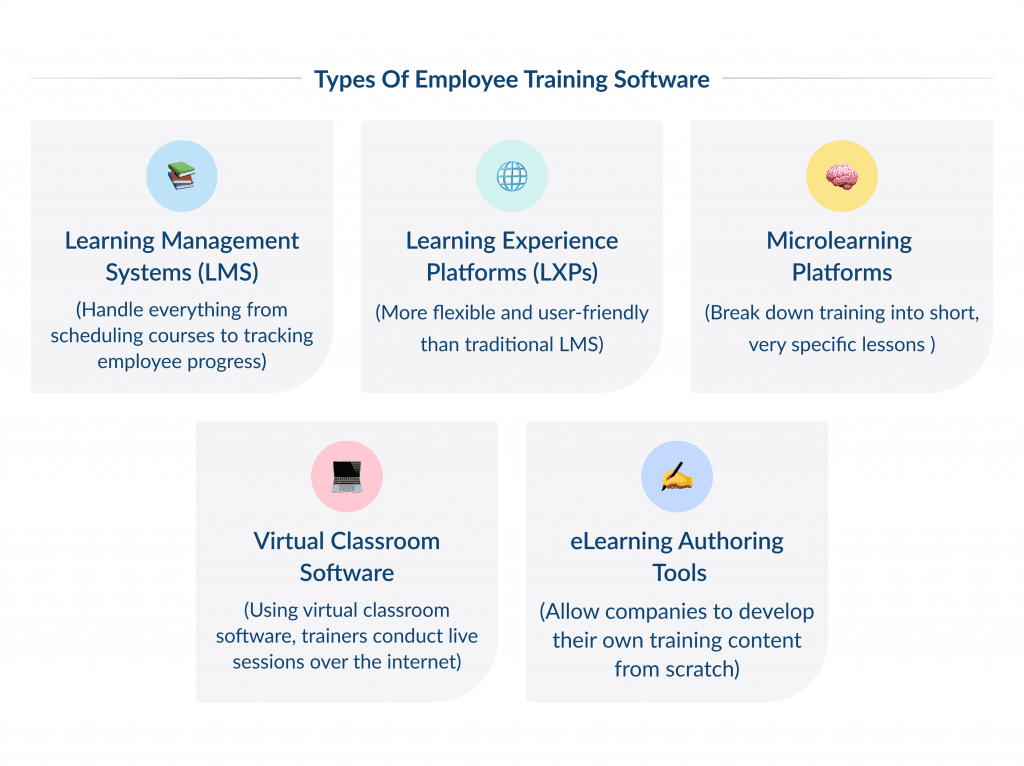
Key Features of Employee Training Software
Most of the companies out there say that training and development are crucial aspects of their workflow.
However, learning new stuff can be complicated, especially when people are overwhelmed with other tasks.
According to Ebbinghaus’ Forgetting Curve, people tend to forget what they’ve learned after a few hours without the right knowledge reinforcement.
In this case, employers who invested in online courses and training programs might waste their time and money if it’s treated as a one-and-done procedure.

So, what should companies do then?
Implement a comprehensive employee training strategy that goes beyond one-day seminars or self-paced, general e-learning courses.
In order for new information to stick, the training process needs to blend into the employee’s day-to-day.
This is exactly what employee training software is made for.
Let’s explore the top features of the best employee training software and why each of these features matters.
Course Management
With course management features, companies can create, organize, and manage training content in a structured way.
This feature helps make sure that employees are learning using the most relevant and updated learning materials.
Course management also streamlines assigning courses based on roles, departments, or career goals.
Mobile Accessibility
It’s no secret that remote work and on-the-go learning are becoming more common.
Hence, employees need to be able to access training from anywhere on mobile devices.
Mobile accessibility allows employees to learn at their own pace, whether they’re commuting, working remotely, or in the office.
Personalized Learning Paths
Personalized learning paths ensure that training courses are tailored to each employee’s role, skill level, and career development goals.
This helps to keep the training relevant and boost employee engagement and satisfaction.
With personalized learning paths, people can actually progress faster as they focus solely on what’s important to them.
Reporting and Analytics
Simply going through the training courses is not quite effective.
HRs and managers should see the progress and effectiveness of training programs.
That’s why all the best employee training software solutions provide analytics and reporting features.
These provide insights into who has completed their courses, how well they performed, and whether the training is having the desired impact.
This helps HR and management make data-driven decisions on training improvements and individual performance evaluations.
Gamification
Whether we are learning at school or using learning management system at work, the learning process is much more fun when it is gamified.
Adding quizzes, simple games, badges, and leaderboards helps motivate employees and make learning more engaging.
Also, gamification taps into employees’ competitive spirit, turning learning into a more enjoyable experience.
For example, at Salesforce, employees earn badges for completing certain training modules.
It fosters a sense of achievement and encourages them to keep progressing through their training.

Social Learning
Learning becomes even more fun and interesting when it is a shared experience.
Social learning features, such as discussion forums, peer reviews, and collaborative learning tools, allow employees to learn from one another.
This creates a sense of community, helping employees solve problems together, rather than learning in isolation.
Certification and Compliance Tracking
There are many industries that require employees to maintain certifications or comply with specific regulations.
In industries like healthcare, finance, and insurtech certain roles require employees to maintain certifications or comply with specific regulations.
Learning software that tracks certification renewal and compliance helps specialists to stay qualified and track that the company meets all legal requirements.
Find out how healthcare technology trends are transforming patient care and healthcare delivery.
Content Library and Authoring Tools
A content library gives companies instant access to pre-built, high quality learning content, which can be a big time-saver.
Instead of spending weeks building new courses, employees can get into industry standard training on leadership, compliance, communication skills or technical knowledge straight away.
This is especially useful for onboarding new team members or developing skills in areas that don’t need to be customized to the company’s specific operations.
Assessments and Feedback
Assessment and feedback are crucial features of employee training solutions.
Assessments help evaluate whether employees are actually learning something.
And a feedback feature allows them to voice their thoughts on the training programs.
This gives companies the chance to improve the learning experience.
Quizzes, regular knowledge checks, grading system, and feedback forms can help managers better assess the learning efforts of their workers and receive a valuable feedback.
Integration with Other Systems
To truly get the most out of employee training, it’s essential that learning software works smoothly with other systems a company already uses, like HR, performance management, and talent acquisition platforms.
When everything is connected, it’s easier for HR and managers to see how training is impacting employee performance, promotions, and overall growth.
For instance, when training software is linked to a performance management system, companies can track an employee’s progress directly alongside their performance reviews.
If someone completes a leadership course and their on-the-job performance improves, management can easily spot the connection and use that information to shape future development plans.
It also makes onboarding much easier, as new employees can be automatically enrolled in the training they need right from day one.
In more advanced setups, learning software can even sync with tools like customer relationship management (CRM) or productivity platforms.
If you’re interested in how to build CRM from scratch, our guide will give you all the tools and insights you need.
This means that sales or customer service teams, for example, can access relevant training content exactly when they need it, based on what’s happening in real-time at work.
Make sure your business strategy stays on track with insights from this CLTV calculator — it’s a handy tool for adjusting your approach as needed.
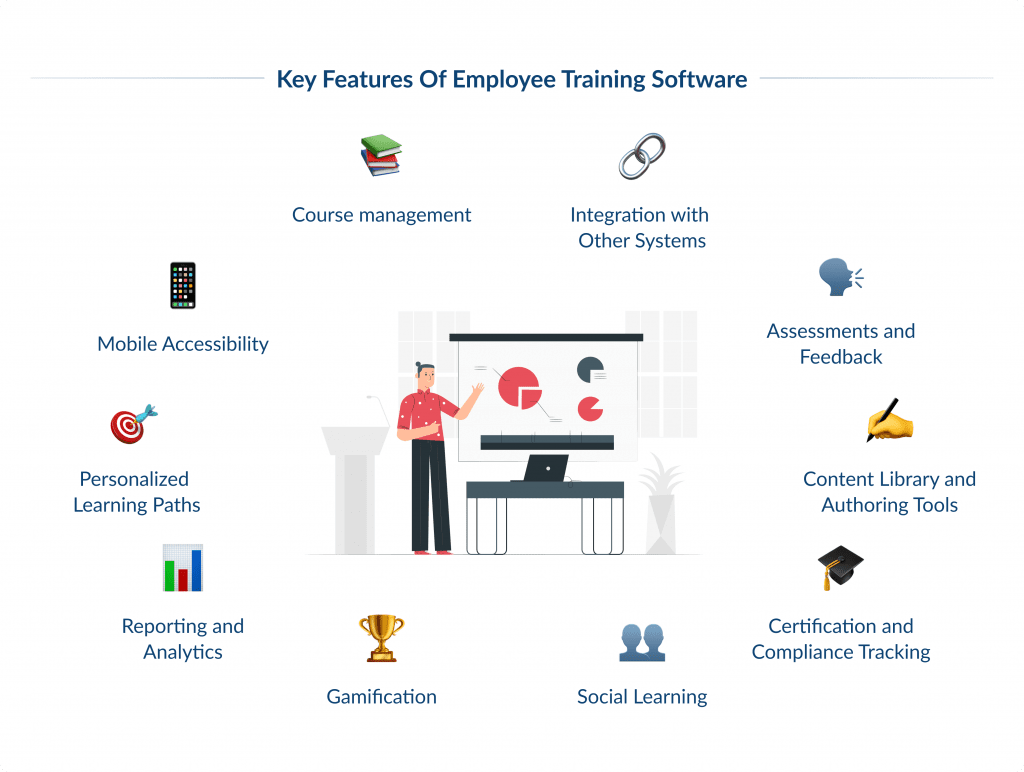
Benefits of Modern Employee Training Software
Training employees is a complex and ongoing process. But it comes with numerous benefits.
In fact, 40% of Fortune 500 companies use Learning Management Systems (LMS) to stay competitive.
Here are a few more benefits of using training software for training management:
- Improved performance and job satisfaction
- Enhanced learning experience
- Increased employee engagement
- Better compliance tracking
- Reduced training costs
- Increased sales and revenue
- Faster course creation
- Better learning flexibility
- Personalized learning paths
- Faster onboarding
- Continuous learning
- Enhanced collaboration thanks to social learning
All these benefits we’ve listed above make employee training software a truly powerful tool for businesses who want to improve performance, reduce costs, and enhance employee satisfaction.
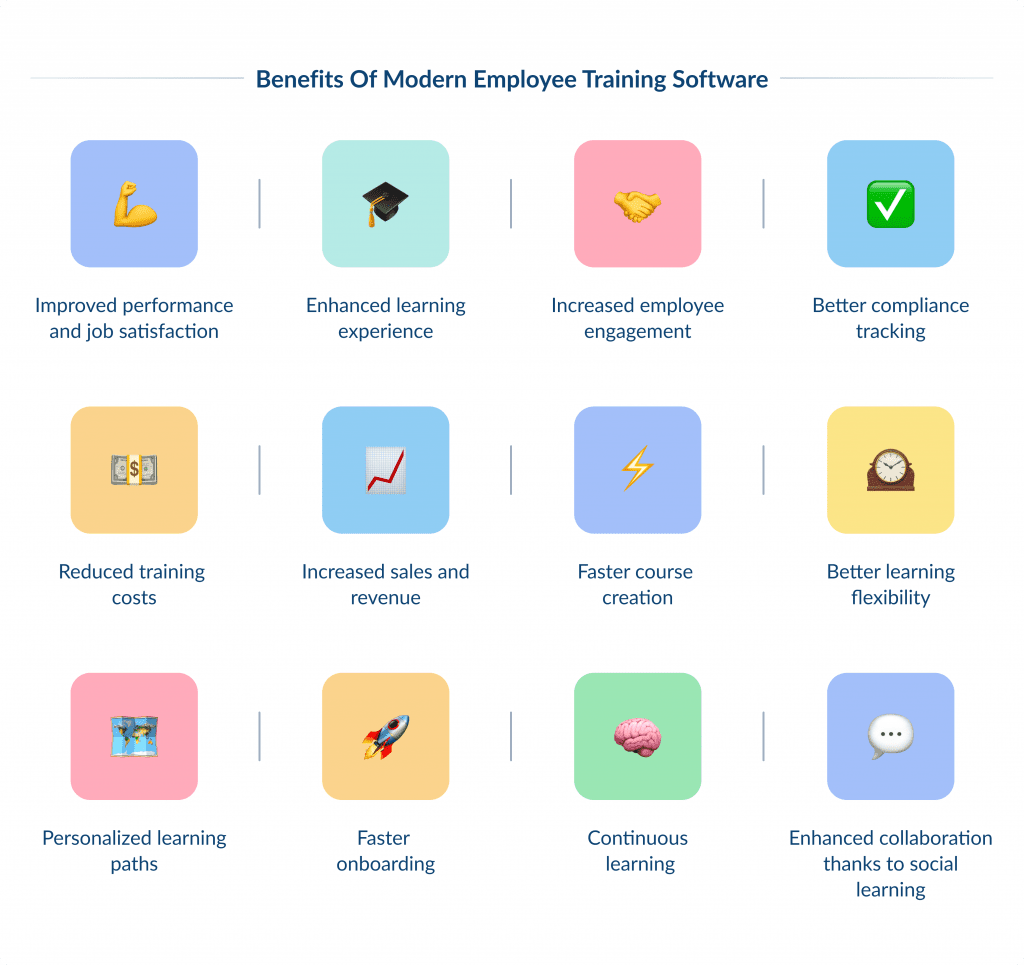
Now that we have explored the must-have features and benefits of these software solutions let’s see how you can actually have one developed.
Best Practices for Employee Training Software Development
At SpdLoad, we have been developing HR and e-learning software for over ten years.
During this time, we have acquired the best practices that help us develop learning management software that is both effective and user-friendly.
Here is how we build an employee training software solution:
Discovery and Planning
We start off with the discovery stage.
At this point, we identify key training goals and business objectives.
To do so, we research user needs and preferences (e.g., employees, HR managers), analyze competitors and existing solutions.
Based on the gathered data, we define the type of training software, its core features and functionalities.
Then, we agree on a project roadmap and timelines.
Design
Once the roadmap and timeslines are set, we move on to developing user personas to guide user experience (UX) design.
We always prioritize intuitive navigation and make sure the interface is user-friendly.
Employee training software market is overcrowded with web-only solutions. So, we make sure the sfotware we develop is mobile-friendly too.
This way, employees can learn on the go whenever they want.
Another important aspect we pay attention to is accessibility.
This means following certain guidelines, like WCAG, to ensure that people with visual, hearing, or mobility challenges can easily navigate and engage with the platform.
Simple features like being able to adjust text sizes or using a screen reader can make a big difference.
By the end of this stage, we create wireframes and mockups showcasing the functionality and user flow.
Explore examples of good web design that combine functionality and creativity
Development
Once the client approves the design, we move on to developing the software.
First, we choose the right tech stack to ensure software scalability and flexibility.
It’s also important to make sure the training platform connects seamlessly with the systems like HR tools or CRM so everything flows smoothly behind the scenes.
This guide to choosing the best recruitment CRM highlights top features that improve hiring efficiency.
Build-in tools let companies easily create or update training content. It makes life easier for learning teams, ensuring courses stay fresh and relevant.
Plus, we can add fun elements like quizzes, badges, or leaderboards that can really boost engagement.
Our developers follow standards like SCORM or xAPI.
We make sure the training content works well across different devices, giving employees a smooth, consistent experience no matter how they access it.
Testing
At the testing stage, we check if the software works as smoothly as planned.
We engage both testers and real employees to try out the software to see if it’s easy to use and if all the features function as they should.
Testing across different devices and browsers ensures that no matter if someone’s using a laptop, tablet, or smartphone, they’ll have the same seamless experience.
And we don’t neglect security tests as well and perform checks to protect sensitive employee data and make sure the platform can handle large numbers of users without crashing.
Want to boost your startup’s success? Try these five usability testing ways to ensure a seamless user experience.

Launch
Once everything is tested and the bugs are fixed, the software goes live.
But it’s smart to start small.
A pilot program with a select group of employees can provide valuable feedback before rolling it out company-wide.
For example, it can be a compliance training to start with, and then, after improvements we roll out other employee training programs.
We provide clear instructions and support during the launch to help employees feel comfortable using the new system.
Monitoring the platform’s performance closely in the early days is key.
Our specialists keep an eye on any hiccups or areas that might need adjusting.
It’s also a good idea to have help resources available, like tutorials or a support team, so employees can get assistance quickly if they need it.
In this article, we break down the cost to build your own HR software, from essential features to advanced integrations.
Explore how you can dominate the industry with our custom software development services
Case Study: Learning System Development for Aviation School
One of the projects we’ve been working on is a learning management system for a school of aviation.
The client reached out to us to develop a comprehensive learning platform for their employees and students.
The goal was to build a modern online training platform that would change the way they delivered training to future pilots.
The catch was that their students were located all over the world, juggling full time jobs and study schedules and they needed a system that was flexible, seamless and tailored to the unique demands of aviation education.
So, the task was not just to develop another e-learning platform.
It was about building a tool that would support students through some of the toughest exams in the industry – whether they were prepping for ATPL, CPL or other key qualifications.
After agreeing on the functionality and deadlines, we moved on to the development.

There were a few challenges we faced.
The first challenge was integration.
The client’s existing systems had a lot of data – student records, exam schedules, course materials – but it was all over the place.
We knew that getting everything together with real-time data sync was key to giving their students a seamless experience.
Imagine an employee training platform where your HR system, performance tools and learning modules all talk to each other – that’s what we aimed to do for school students and administrators.
But it wasn’t just about getting the data right.
Aviation, like many other industries, is all about precision.
The client needed their content tailored to the exacting requirements of aviation education.
To do so, we developed custom data mapping solutions to ensure all the important stuff – student progress, exam results – was consistent, accurate and easily accessible.
And we added features that made learning fun.
With a searchable video library and interactive tools to track engagement, students had the flexibility and control they needed.
These interactive bits – whether it’s a quiz after a lesson or notifications about new courses – are what keep learners engaged and motivated.
In the end, it wasn’t just about building professional software. It was about building a bridge between the client’s decades of experience and the next generation of pilots.
And that’s what modern training software can do for any company: create meaningful, engaging experiences that align with business goals and employee growth.

The Future of Employee Training Software
Choosing the best recruitment CRM allows your HR team to focus on building relationships rather than managing data.
As the technology moves forward, so does the training program software.
Here are a few trends that all the best employee training software will have in common in the next few years.
AI for Employee Training Personalization
Human-centered approach is everywhere.
And employee training is not an exception.
According to LinkedIn Learning’s 2023 Workplace Learning Report, personalized learning is a key trend. 75% of L&D professionals are using AI to tailor training.
Personalized learning paths use data and AI to tailor training content to individual employees’ needs, skills, and career goals.
AI can be a complex field, but understanding the basics is easier with our comprehensive AI glossary.
Microlearning
The abovementioned microlearning breaks down training into small, focused segments, making it easier for employees to absorb and remember information.
Each segment lasts just a few minutes, so it fits well into busy schedules and allows for learning during short breaks.
This method helps employees quickly grasp key concepts and apply them immediately to their work.
Studies show that microlearning enhances information retention and keeps employees more engaged with interactive content.
Training in bite-sized pieces helps employees integrate new skills into their daily tasks more effectively.
This approach makes learning less overwhelming and more practical for the fast-paced work environment.
Virtual and Augmented Reality
Virtual and augmented reality are changing the way we engage, buy stuff online, and learn something new.
In employee training software, VR and AR help create immersive learning experiences that simulate real-life scenarios for hands-on training.
Explore the numbers behind the augmented reality boom in our latest AR statistics report.
These technologies offer practical, interactive training that can enhance learning outcomes and skills application.
The 2023 VR/AR Training Report highlights that VR and AR can improve retention rates and reduce training time.

These are just a few trends we’ve outlined here, but we can clearly see that the penetration of modern technologies is changing the way we learn.
The future of employee training software is personalized, AI-based, seasoned with VR & AR, accessible, and can seamlessly be integrated into our busy lives.
Stay ahead of the curve with the latest application development trends that are shaping the industry.
Conclusion: How to Build the Best Employee Training Software
Employee training software is much more than a digital tool.
It’s a game-changer for any organization looking to nurture and develop its talent.
With the right employee training software, you can transform your training programs and make them more effective and engaging while reducing costs.
This translates into better performance, happier employees, and a stronger team.
To truly make the most of your training software, our team will focus on creating a platform that’s accessible and easy to use.
An ideal platform will also integrate smoothly with your existing systems and fit into the daily flow of work.
To keep up with the pace of time, we use emerging technologies, including AI, VR, and AR.
Incorporating these advanced features will help keep your training relevant and exciting and provide immersive learning experiences that captivate and educate.
After all, building the best employee training software is about more than just picking the right features.
It’s about creating an experience that supports your employees’ growth and aligns with your organization’s goals.
With the right approach, you’ll not only enhance your team’s skills but also foster a culture of continuous learning and development.
Would you like to learn more about how we approach HR software development?
Feel free to contact SpdLoad, and we will get back to you as soon as we can.




